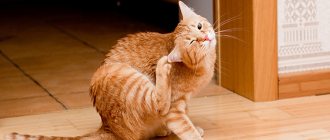Cat fleas are small brown insects that feed on the blood of animals and humans.
Many people, wondering whether cat fleas are transmitted and are harmful to humans, do not want to have pets. This is not surprising, since indoor bloodsuckers can be carriers of various diseases. But fleas do not live on the human body; it does not act as a favorable environment for production. Parasites use people only as food, but even so they can cause a lot of trouble.
To get rid of them, use anti-flea shampoos, sprays, drops or collars. The choice is based on the preferences of the owner, pet, and veterinarian recommendations.
Are they transmitted to humans?
Fleas are small, dark brown insects that feed on blood. Their body length does not exceed 3-4 mm. They move by jumping or running. A cat can be a carrier of any type of floor flea. More often she catches them while walking outside to avoid animals.
When wondering whether fleas from a cat can spread to the human body, one should clarify the fact that bloodsuckers do not live on people. Therefore, they cannot be transmitted from animals.
Parasites feed on the blood of warm-blooded creatures, which can include humans. But having received what they need, they leave. Fleas can live in a home, on pets, but not on the body of the owner of the house. At the same time, animals that have constant contact with humans can become infected from him if bloodsuckers are brought from the street with clothes and shoes.
When answering the question of whether cat fleas jump on humans, it should be taken into account that parasites move by crawling and jumping. The length of their jump can reach 30 cm. This is enough to move from the floor to the lower part of the victim’s body. That's why the legs are bitten more often. The arms, back and neck suffer if the animal sleeps on the bed with the owner, and the parasites can reach any area of the body.
Control of parasites in animals
You can tell if a cat is infested with fleas by several signs:
- the animal often itches and bites itself;
- the cat's skin becomes covered with red spots - traces of bites;
- Black dots appear in the fur - flea excrement.
If there are a lot of insects, they can be easily seen with the naked eye if you part the fur. A kitten picked up on the street can become a real breeding ground for parasites.
If you don't take action, your cat's body will weaken. The animal will become lethargic, its appetite will worsen, and it will have problems sleeping. Due to constant scratching, the bite sites become inflamed, abscesses, fistulas, and allergic dermatitis form.
To prevent fleas from passing from cats to humans, they must be gotten rid of immediately. The most popular method is to bathe your pet with insecticidal shampoo. Modern detergents kill insects from the first use.
There are other ways to get rid of fleas in cats:
- Anti-flea collar – can be impregnated with repellent or insecticide. In the first case, the accessory only repels fleas, so it is better to put it on an already treated cat. Collars with insecticidal substances destroy insects, but in the area of the hind legs and tail their effect is practically not felt. The validity period depends on the composition of the product, usually it is 2-3 months.
- Sprays can both repel and kill fleas. The drug is applied to the entire body of the animal, so there is no chance for insects to sit on the tail or thighs. Disadvantages - the likelihood of intoxication in cats with hypersensitivity, the result lasts only 5-10 days.
- Drops are concentrated solutions with insecticides or repellents. They are applied to the back of the head, which is not accessible when licking. However, the animal runs the risk of poisoning if the owner exceeds the recommended dosage or applies the product to an easily accessible place.
- Tablets are a relatively new development. The active ingredients enter the cat's bloodstream and destroy fleas during a bite. Within a few days, all toxic substances are eliminated from the animal’s body. Cons: additional stress on the liver and kidneys. Such drugs are used only under the supervision of a veterinarian.
Manufacturers produce a whole series of products to combat fleas in cats. Among them you can find all the indicated types of drugs.
Brands that have proven themselves well:
- "Leopard";
- "Ms.Kiss";
- "Beaphar"
- "Doctor Zoo";
- "4 with a tail";
- "Bravecto";
- "Frontline";
- "BlochNet."
Before using any drug, you must carefully read the instructions. Some products cannot be used on kittens, pregnant and lactating cats, weakened and elderly animals.
Important. Fleas develop immunity to insecticides that are constantly used on cats. Therefore, it is not advisable to constantly use the same product.
Do they bite?
When wondering whether cat and dog fleas can bite a person, it is worth noting that bloodsuckers do not care what kind of blood they feed on. Insects live on pets, but can also gnaw their owners if there is not enough blood from the animal. This usually happens when there is a small kitten in the house. His body cannot saturate the horde of parasites, then the latter look for food elsewhere.
Interesting fact: cat fleas, unlike dog fleas, bite people more often. After purchasing a pet or before going to an area where pets roam, you should take measures to prevent bites. For animals, these can be collars, gels, sprays, and for humans, special repellent ointments.
Prevention
As you know, it is better to prevent a disease than to treat it. Therefore, pet owners are recommended to occasionally examine their pet for the presence of blood-sucking pests on its fur.
You need to periodically inspect your cat's bedding and the places where it spends most of its time. Be attentive to the animal's behavior.
If a cat is infected with fleas, then you need to immediately start fighting the bloodsuckers in order to completely get rid of them. To eliminate fleas in cats, you can use the following products:
- drops on the withers;
- sprays;
- shampoos for animals;
- anti-flea collars.
After using any of the products, the cat does not need to be washed for three days. Your veterinarian will tell you what to do and which anti-flea remedy to choose, or a specialist at a veterinary pharmacy will advise you.
Fleas are transmitted from cats to humans, from animal to animal, but in addition to treating animal hair, it is also recommended to treat the apartment. Fleas can hide in upholstered furniture, carpets, baseboards, and secluded corners. Getting rid of fleas indoors can be difficult. It is necessary to vacuum the entire room, wash soft toys, clean upholstered furniture, and carry out a complete wet cleaning of the room. Afterwards, the apartment needs to be treated with special anti-parasite compounds. If there are too many fleas, it is recommended to contact an exterminator. This will most likely require temporary relocation of people to another place of residence.
To avoid re-infection of animals, you need to follow preventive measures:
- Treat the animal with anti-flea drugs once a month.
- Regularly clean and inspect your cat's bedding or bed for the presence of fleas.
- Maintaining cleanliness in the apartment.
- Avoid contact between indoor cats and street cats so that the animal cannot become infected with fleas from them. Street cats and their habitats (near entrances, in basements) are the most contagious.
- If fleas are detected, you need to take action to combat the parasites in order to get rid of them without allowing them to reproduce.
Follow simple rules of prevention, and then you will protect your furry pet, yourself and your home.
Symptoms of a human being bitten by a cat flea
On the human body, a cat flea bite is recognized by the following signs:
- Fleas, unlike bedbugs, can bite at any time of the day or night.
- Cat flea bites on a person’s body are located no more often than 2-3 cm apart from each other. They can be localized in the area of the arms, back, lower leg, and neck.
- Blisters form in the area of the bite. They swell and take a long time to heal.
- The area around the blister may be itchy and painful.
- The bite is painful because an enzyme in the saliva prevents blood from clotting.
With individual intolerance to the saliva of the parasite, some people, when fleas from cats or dogs are temporarily transmitted to a person, experience a severe allergic reaction.
In this case, antihistamines and ambulance are needed.
Symptoms of aphanipterosis in cats
You can judge whether the fleas of a cat, cat or kitten are dangerous for humans by the frequency of bites and consequences. During the day, bloodsuckers make up to 300 punctures with piercing-sucking proboscis, secreting saliva with hemolytic toxins into the wounds. Inflamed, itchy spots remain on the pet's stomach, back, and inner thighs.
When licking fur, saliva gets on the tongue and allergic reactions develop. They are considered the causes of dermatological diseases. Due to itching to the point of bleeding, cats scratch their skin and locally gnaw out fur. In these places, wet, itchy eczema with brown papules appears that require treatment.
Danger to humans
When understanding the question of whether cat and dog fleas are dangerous for humans, it should be noted that the parasites themselves do not pose a threat to the victim. But if the insect has been in contact with an unhealthy animal and acts as a carrier of the disease, then when bitten, the infection can penetrate into the wound.
Therefore, concluding, doctors say that fleas living on a cat can be dangerous to humans, transmitting to them through the blood:
- Pulicosis.
- Dermatitis.
- Hepatitis.
- Typhus.
- Brucellosis.
- Salmonellosis.
- Encephalitis.
- Helminthiasis.
- Dipilidosis.
- Fever.
- Erythema.
In the Middle Ages, cat fleas caused a plague epidemic, which was dangerous for humans.
Nowadays, fleas rarely cause serious problems when they jump from cats to people. More often, patients suffer from helminthiasis; sometimes, due to intolerance, an individual severe allergic reaction occurs.
Treating bites
Usually, if fleas have bitten a person, the discomfort goes away after a few days. But if the pain and itching does not go away within a few days, then the wounds need to be treated. They can be lubricated with a small amount of any anti-inflammatory agent that will relieve burning, itching and redness.
Experts advise people to treat insect bites in the following order:
- Wash the affected skin with water and soap, or treat with an antiseptic.
- Apply ice to the bite site.
- You can eliminate itching from a flea bite with a soda solution or sulfur ointment.
- Treat the bite site with brilliant green, iodine, and ethyl alcohol.
- If allergies occur, it is recommended to take an antihistamine.
Can they live on humans?
When answering the question of whether fleas pass from cats and dogs to people, they definitely say that they do not stay on the body for long. Having bitten the owner, the bloodsuckers jump to the floor to further lay eggs. Basically, adult individuals parasitize animals and hide in the fur of pets; people do not have productive “vegetation,” which makes insects uncomfortable when attaching. Hence, some individuals suspect that cat fleas can live in human hair, which imitates animal fur. This is also incorrect, since the human body has a temperature of 36.6 C, and in animals this figure reaches 38-39 C, which significantly improves living conditions for pets.
Therefore, if there is any doubt whether cat fleas can live on humans, the answer is no. The appearance of blood-sucking parasites occurs near the location of the victim. A large number of fleas are found not only on the body, but also on animal rugs or floor carpets. If we talk about the street, then insects settle under leaves, stones, in garbage, and rodent burrows. By temperature fluctuations, vibrations, and smell, they determine the appearance of the victim, jumping onto it.
Insect development cycle
The flea development cycle can take from 10 days to several months. It all depends on environmental conditions. In warm weather, reproduction occurs as quickly as possible; with the onset of cold weather, it slows down or temporarily stops.
Insects develop in 4 stages:
- The adult lays eggs. Most often, they roll off the host animal and spread freely throughout the apartment.
- A worm-like larva about 1 mm long emerges from the egg, capable of moving independently. It usually lives in the cat's bedding and feeds on the feces of adult fleas, dried blood and various organic debris.
- The larva develops, molts three times and pupates, entangling itself in a silk-like cocoon.
- After some time, an adult insect is born.
Eggs are very resistant to adverse factors. They can lie in some secluded corner for months, maintaining their viability. As soon as suitable conditions arise, their development cycle resumes. The most favorable temperatures are considered to be +18…24 °C and air humidity of about 60%.
For your information. The average lifespan of an adult flea is 2-3 months. During this time, she manages to lay 500-800 eggs.
A cat's resting place is a flea breeding ground
Usually, cat fleas, having fed and satiated with the blood of the animal, leave their usual carrier to lay eggs. For this purpose, a place with high humidity and no access to sunlight is suitable for them. Some species groups of parasites reproduce their own kind directly on the host. Meanwhile, jumping insects, remaining near the egg clutch for some time, can attack a passing “victim”, including a person who does not always feel how they bite him. The flea senses the approach of a potential “breadwinner”, information about which is conveyed to it by air vibration, temperature fluctuations, odors and carbon dioxide emissions.
In general, it should be noted that parasites jumping on a person can not be found very often, for example, in the case when the pet has more than just cat fleas. Having brought home insects dangerous to humans on itself, the cat settles down as usual in its favorite resting place, and at this time human fleas are located nearby, awaiting their long-awaited owner. And so, as soon as a guest approaches the cat’s house, the parasite, sensing the smell of his sweat or breath, attacks.
How to protect yourself
Is there a universal flea repellent? Of course, you can use a repellent, but most likely an ordinary person will not have the opportunity to apply it constantly, that is, every time he leaves the house and even in his own apartment (if he has pets going for walks).
It can be concluded that cat fleas also have a negative impact on humans. To avoid unwanted consequences, you should be vigilant and pay more attention to your pets.
Fleas are very small insects that feed on the blood of various animals. Most of us do not even suspect that these insects cause trouble not only with their bites themselves, but also with their consequences. More than 60 species of these bloodsuckers can be found in our country alone. There are about 2 thousand varieties of them around the world.
Main symptoms
Cat fleas can be transmitted to humans, so it is very important to promptly recognize a pet infestation and take action. At the first stage, the cat scratches itself only occasionally; in general, the animal’s behavior is no different from its usual one, so at this stage it is difficult to notice anything. Only an experienced owner can understand that something bad has happened to a pet.
At the second stage, symptoms already become obvious:
- the animal behaves restlessly;
- the pet constantly bites itself, trying to eliminate pests;
- the pet refuses to take food, its appetite worsens;
- the cat meows all the time, calling the owner for help;
- Your furry pet's sleep is getting worse.
At this stage, you can examine the parasites by parting the cat's fur. There are many scratches, bites, and bloody wounds on the animal’s body. As the disease progresses, the pet becomes nervous and restless, eats little and loses weight. His hair falls out and bald spots form. Allergic dermatitis may appear. In this case, you need to urgently save the animal.
Sometimes a large number of fleas can cause death. A kitten suffering from fleas often develops anemia.
How do parasites threaten humans?
In addition to being an annoying “neighborhood”, these creatures can cause a lot of problems not only for animals. They actually transfer to people and can “reward” them with unpleasant problems with unpredictable consequences. It is not surprising that owners of four-legged animals, as a rule, try to quickly get rid of the potential danger in the form of blood-sucking cats or dogs. Surely many people remember from history the frightening events of the Middle Ages, when almost half of the population of the Old World died from the bubonic plague, which was carried by fleas.
At the same time, there is no need to panic. The likelihood of a pet becoming infected with fleas does not mean that cats should not have a place in a human home. If only because not all types of fleas that live on cats can pass to humans. In addition, four-legged domestic animals are not bitten by parasites that carry such a terrible disease as plague. Therefore, you should not be afraid of such blood-sucking creatures, but it is imperative to fight them.
What do we know about fleas?
The flea is a blood-sucking ectoparasite, characterized by its small size (on average 1-5 mm, but there are larger exceptions) and also its phenomenal jumping ability. The color of the chitinous exoskeleton of this jumper varies from classic brown to deep black.
The habitat of fleas is incredibly large. These small bloodsuckers can be found even in the snows of the Arctic.
Fleas are not picky in choosing a host. They are able to parasitize all warm-blooded creatures, especially cats and dogs due to their thick fur. They are not found only in fish and various amphibian-reptiles.
Since the community of warm-blooded animals is very diverse, including the class of birds, fleas for each species have some differences in appearance. But the fundamental signs are the same for everyone. Based on them, zoologists classified all flea families into one order.
How do fleas get from animals to humans?
How high the likelihood of people being affected by cat fleas can be understood based on the characteristics of the parasite's introduction to a new host. For example, an ordinary furry pet walking somewhere in the garden or on the street performs a transport function for the insect. Fleas can make incredible leaps when exploring new territory. Once on an unfamiliar area of fur, the parasite moves slowly along the unexplored surface. But when the cat returns home, he manages to get rid of those insects for which he is not a comfortable and most suitable carrier.
Such fleas end up on furniture or the floor. It is impossible to say with certainty how dangerous they are for people. Of course, parasites bite humans and happily drink blood, the composition of which is optimal for them. At the same time, a human body not covered with thick hair is not exactly the conditions that fleas need to live: they cannot hide anywhere there. If parasites begin to actively attack family members living in the house, it means they are hungry or the time has come for their maximum physical activity.
Do cat and dog fleas bite people: how do animal fleas bite, why are they harmful, how to prevent
The flea is a small but extremely unpleasant parasite that lives on animals. She hides in their thick fur, jumps very far, and it’s not so easy to crush her.
Fleas can change their hosts by quickly moving through space. And quite naturally the question arises: do cat or dog fleas bite people? How dangerous are they?
What are cat and dog fleas?
Most often, people are bitten by fleas that are on their pets or come from somewhere in the external environment. These insects exist everywhere.
The most common types of fleas are:
- feline,
- canine,
- rat,
- human.
Cat and dog fleas are the most common. They are very similar, and the differences between the types of parasites can only be seen under a microscope.
Fleas are classified according to their habitat:
- earthen,
- home (bed),
- sandy
Life cycle of a flea
During its life, a flea goes through the usual life cycle for insects:
- egg,
- larva,
- doll,
- adult.
Insects can always reproduce; the most important condition is a comfortable temperature (18-25°C) and the availability of food. The eggs of parasites are very small, similar to rice, but much smaller, white, translucent.
After mating, the female lays, or rather scatters, eggs into the external environment, where they remain for up to 10 days. The eggs are placed at a considerable distance from each other, which helps them survive and avoid competition.
Flea larvae are not similar to adult flea parasites. These are white-yellowish worms up to 5 mm long, with a hairy covering. They, unlike adult insects, feed not on blood, but on flea excrement, skin, plant debris and animal food.
After 10 days, the larva begins to pupate, forming a cocoon around itself. In the cold, it can spend several months in it, and in favorable conditions it will hatch in about five days.
Fleas feel very comfortable in warmth. But if the temperature drops, they can go for months without food, maintaining mobility, but they cannot reproduce.
Features of the oral apparatus
The flea's mouthparts are of the piercing-sucking type. It consists of three stabbing stilettos folding into a tube. By piercing the skin, they penetrate the blood vessel and draw in blood.
When bitten, a flea does not release any painkillers; it only introduces an enzyme that prevents blood clotting.
Where do cats get fleas?
Fleas are very common in cats. The most common causes of these insects in cats are:
- communication with infected, most often homeless animals,
- rugs, houses of infected animals,
- wild animals and rodents,
- flea-infested basements of houses,
- walks in the forest, field, meadow,
- livestock farms (especially those with rabbits).
What fleas bite people
Any flea, including cat and dog fleas, can bite a person. Many pet owners may suffer in this regard from their pets. But these insects cannot live on humans, since they have nowhere to hide on the human body.
If you do not monitor the health of your pets, fleas can multiply and migrate from their fur into the bedding, onto carpets, into clothes and bite a person.
Flea bite: what does it look like and what to do?
This is what flea bites look like:
If you are bitten by fleas, you should take the following measures:
- Rinse the bite area with cool water. Treat with hydrogen peroxide or chlorhexidine, this will reduce the risk of inflammation.
- An ordinary ice cube from the refrigerator or antipruritic ointment (Fenistil, Flucinar, Rescuer) can relieve itching.
- If an allergic reaction occurs, take an antihistamine (Suprastin).
- If any complications arise (swelling, increased itching, inflammation), consult a doctor.
Differences between flea bites and other insect bites
Flea bites are most similar in nature to bedbug bites. But upon closer examination they have significant differences.
- Bedbugs inject an anesthetic into the wound, so at first their bites are not felt. A flea bite is immediately felt by a sharp pain, since fleas do not anesthetize their bites.
- After flea bites, there are no blood spots left, like bedbugs, but there may be subcutaneous hemorrhages.
- A sign of flea bites is groups of 2-3 bites nearby, especially on the legs. After bedbug bites, “tracks” of small red spots remain on the body.
- After flea bites, red spots appear around the wound.
- A biting flea is difficult to detect, unlike an ant or mosquito. She is very mobile.
FAQ
Can fleas attack humans?
Fleas are quite dangerous for people, as they are carriers of various dangerous diseases:
- plague,
- brucellosis,
- encephalitis,
- hepatitis A,
- anthrax,
- salmonellosis,
- helminthiasis, etc.
A flea bite is painful and, in addition to the dangerous diseases listed above, can cause itching and inflammation of the skin (pulicosis).
These insects can attack people if they have no one else to bite or if their population greatly increases.
Do cat fleas live on people?
Although they cannot live on humans, they can bite, especially if they have multiplied heavily on your pet or appeared from somewhere in the house.
They need to drink blood for survival and reproduction.
Why do fleas bite some people and not others?
This is not true, fleas bite all people, they only give preference to those with thin skin, since they have blood vessels closer to the surface. Therefore, under the same conditions, it is possible to detect flea bites on some people, but not on others. Children are especially affected as they have delicate skin and are more prone to allergic reactions than adults.
People with rough skin, excess subcutaneous fat, and no severe allergies may not even notice the bites of these insects.
Ways to control fleas in cats and dogs
There are many different methods of combating these insects, both chemical and folk. The most common means are:
- shampoos,
- drops,
- collars,
- sprays.
Flea shampoos
They have a small amount of toxic substances and are easy to use. Even small kittens and puppies from 1 month can be bathed with anti-flea shampoo. Many of the drugs are made on the basis of medicinal herbs. The most popular brands of shampoos are presented below.
- Phytoelite
- made from medicinal herbs,
- effective,
- easy to apply
- destroys other parasites,
- can be used from 2 months of age.
- short-term effect
- Repeat treatments may be required.
Powerful insecticidal shampoo against insects that parasitize animals. The main active component is permethrin, decoctions of wormwood, celandine, and sodium laureth sulfate are added. It is necessary to wet the animal's fur, apply shampoo and leave it on the body for 3-5 minutes, only then rinse.
The water should be warm, but not hot. Under no circumstances should you allow your animal to lick the product from its fur. Belongs to hazard class 4. Available in bottles of various sizes for ease of use. Repeated treatments can be carried out no more often than once every 10 days.
Cost - from 90 rubles.
Advantages:
Flaws:
Leopard
The drug is made on the basis of essential oils of plants (lavender, cloves, pelargonium, costus). Its use is allowed even in small puppies and kittens.
Before treatment, the wool is moistened generously with warm water, then zoo shampoo is applied for 2-3 minutes, rinsed off and the wool is combed. In case of severe contamination, the treatment can be repeated. In addition to fighting parasites, it has a bactericidal effect and heals wounds and cracks. Hazard class - fourth.
Cost - from 180 rubles.
Advantages:
- made from natural raw materials,
- suitable for use in children,
- universal,
- easy to apply,
- highly effective remedy
- improves the condition of the animal's skin and fur,
- fleas disappear after a single application.
Disadvantages: Repeated treatments may be required.
- Dana
- effective,
- destroys not only fleas, but also other parasites,
- has no side effects,
- easy to apply
- has an affordable price,
- One application is enough to remove fleas.
Insectoacaricidal shampoo of contact action. The main active ingredient is permethrin. It is a colorless transparent liquid. Belongs to hazard class 4. Do not treat pregnant or lactating females, puppies or kittens under 12 weeks of age.
Before applying shampoo, the animal’s fur is generously moistened, the product is applied for 5-7 minutes, then rinsed and combed. Dana shampoo diluted with water (1:2) can be used to treat an animal’s rug.
Cost - from 90 rubles.
Advantages:
Flaws:
- It is prohibited to use in pregnant women, sick people, small animals,
- may cause dry skin if used frequently.
Anti-flea drops
All flea drops are applied to the animal's withers. These products are good because they have not only an immediate, but also a prolonged effect, preserving the active substances for a long time. The animal is thus protected from parasites.
Drops are considered a safe means of combating parasites, provided that the instructions for their use are followed. The animal's fur is thoroughly combed, then drops are applied to dry skin in the withers area, between the shoulder blades. The animal is isolated from water and children for the period specified in the instructions.
- Stronghold
- universal action,
- high efficiency,
- simple application,
- long action,
- no smell,
- safety.
- Celandine
- a wide selection of drugs in terms of dosage and depending on the type of animal,
- efficiency,
- prolonged action,
- action against many types of parasites,
- affordable price,
- convenient release form.
An effective solution used in dogs and cats to combat parasites. The active ingredient is selamectin. Drops for dogs and cats are available in different percentages.
They have a convenient release form, in the form of a pipette. Hazard class - third. Cost - from 400 rubles.
Advantages:
Disadvantages: high cost.
Drops against parasites based on permethrin and fipronil. Very strong and effective. Not for use in small puppies and kittens, productive animals.
Hazard class - third. Drops are commercially available and are used for both treatment and prevention purposes. Apply to the animal in the neck area, between the shoulder blades. Be sure to ensure that your pet does not lick the substance.
Cost - from 130 rubles.
Advantages:
Flaws:
- toxicity,
- strong allergenicity.
Drops from a Dutch manufacturer for flea treatment. Thanks to the herbal composition, they are safe even for small kittens, sick and weakened animals. The active substance is margosa plant extract. They protect the animal for a month not only from fleas, but also from ticks.
Apply to dry skin without visible damage in places inaccessible to licking. This is mainly the area of the ridge and neck, between the shoulder blades. Hazard class - fourth.
Cost - from 700 rubles.
Advantages:
- ease of use,
- reliable protection,
- herbal base of the drug,
- universal application,
- effect on many parasites,
- efficiency.
Flaws:
- high price,
- allergic reactions are possible.
Collars
Flea collars are not medicinal products, but they have a preventive effect. Popular with pet owners due to ease of use and effectiveness.
They do not have too long an effect. Especially cheap models are valid for up to 2 months. The more expensive the model, the longer its action and the higher the efficiency.
- Harts
- easy to use,
- effective,
- waterproof,
- long-lasting,
- does not cause allergic reactions,
- nice smell.
- Foresto
- efficiency,
- acts on many parasites,
- long-term effect (up to 8 months),
- protects against fleas,
- convenient to use,
- additionally equipped with reflective clips.
The manufacturer is popular in Russia for its anti-parasite products for pets. Various products are produced, including flea collars for dogs and cats. They are effective and long lasting. Unlike other collars, it lasts about 7 months.
The active ingredient is tetrachlorvinphos. In addition, this model is waterproof and does not lose its properties if it gets into water. This justifies the high cost. Hazard class - fourth. Cost - from 750 rubles.
Advantages:
Disadvantages: high cost.
The manufacturer of the model is a German company. Despite the high cost, it is popular because it has a long-lasting effect and protects animals. Active ingredients: imidacloprid, flumethrin. Effectively fights not only fleas, but also other pests.
It is used for both prevention and treatment. Do not use on young animals, sick animals, pregnant or lactating females. Hazard class - third. Cost - from 1800 rubles.
Advantages:
Flaws:
- high price,
- cannot be used in some animals.
Sprays
There are a huge number of sprays available to combat fleas. When choosing a drug, pay attention to the thickness and length of your pet’s coat, its age and condition.
The animal must be handled carefully so as not to poison it. Be especially careful that he does not lick the product, take care of his eyes. It is better to carry out the treatment outdoors or in a well-ventilated area.
- Frontline
- can be used from two days,
- universal,
- well tolerated by animals
- effective,
- affects all pests.
- Leopard
- easy to apply
- action lasts up to 2 months,
- gets rid of many parasites,
- low cost,
- effective,
- well tolerated.
A powerful concentrated drug that acts on fleas even with severe infestation. The active ingredient is fipronil. Has no side effects.
Destroys most parasites and protects against subsequent infection. The pet's fur should be damp after treatment. Do not wash for several days, do not contact the animal with children and other animals. Hazard class - third.
Cost - from 550 rubles.
Advantages:
Disadvantages: not suitable for animals with long hair.
Contact insecticidal spray for flea treatment. Active ingredients: permethrin, fipronil.
Already after the first use the effect is noticeable. Use with caution; the product may cause allergic reactions. It is better to carry out the treatment outside. Hazard class - third.
Cost - from 230 rubles.
Advantages:
Flaws:
- Strong smell,
- Not for use in kittens and puppies.
Folk remedies
Many products sold in pharmacies are effective, but toxic. For this reason, many owners do not use them. There are many safe folk remedies that can also be successfully used in the fight against fleas. But folk remedies, although easy to use and accessible, have one significant drawback - they must be used constantly. If you stop treating, the parasites will return.
Sagebrush
The smell of wormwood is not tolerated by most insects. Fleas are no exception. To treat an animal, you need to brew 20 g of dry grass and wipe the animal’s fur with this infusion. This product is safe even for small kittens and puppies.
Garlic
Garlic is a potent remedy. Crush a few cloves of garlic, add water and leave for a day. Then wipe the animal’s withers with this infusion. Under no circumstances should you wipe the entire body; the animal can be poisoned. Garlic is dangerous for your pets' gastrointestinal tract.
Soda and salt
This is a very simple and safe method. Substances can be found in every home. Salt absorbs moisture from the bodies of insects, and they die, and soda destroys even the larvae and eggs of parasites. A mixture of these substances can be used to treat not only wool, but also animal bedding, houses and carpets.
Essential oils
Fleas cannot tolerate strong odors. The great advantage of essential oils is that they have a pleasant smell to humans, so they are easy to use.
Essential oil can be added to shampoo for washing an animal, for washing the floor, and treating bedding.
The following essential oils are used:
- eucalyptus,
- tea tree,
- mint,
- lavender,
- rosemary,
- lemongrass,
- cedar
Preventing flea infestation
The best way to control fleas is prevention. To do this you need to follow some rules.
- Keep your home clean. Carry out general cleaning more often, do not allow dust to accumulate.
- The flow of fresh air is detrimental to fleas; they cannot stand it. Therefore, ventilate your apartment regularly.
- Use strong-smelling substances for prevention: herbs, essential oils, garlic, vinegar.
- Monitor the health of your pets and inspect their fur. Some products, such as collars, can be used for preventive purposes.
No matter how unpleasant fleas are, they can and should be fought. This can be done using various means: both chemicals and folk recipes.
Are these insects dangerous for the animal owner or not?
It is very important to know how dangerous fleas are for a pet owner who has become ill with parasites. Common bite marks are not harmless: they can have serious consequences:
- Allergy. Usually occurs in people who are prone to similar reactions and often suffer from various irritants. Allergic dermatitis appears on hypersensitive skin. In this case, the allergen is the flea's saliva, which will cause the bitten area to itch for a long time.
- Infection with worms. Parasites are carriers of nematodes, as well as helminths. As a result, dipilidia may develop, during which tapeworms begin to develop in the body. Their largest size in the intestine is 70 cm.
- Bartonellosis. This is a whole group of diseases that differ from each other, but the source of their occurrence is the same - bacteria carried by fleas. All of them pose a potential danger to humans.
All these diseases can be contracted not only at home if your pet catches fleas. But insects can also bite in the entrance, on the street, when interacting with street animals and even with pets.
Fleas can appear in an apartment very easily: you can bring them on shoes or clothes along with dirt.
It is also worth remembering that fleas are capable of giving rise to entire epidemics, which has already happened more than once: they are carriers of typhoid and plague. Therefore, we must not forget about prevention: check your pet as often as possible for the presence of these unpleasant and dangerous insects.











